Key takeaways:
- Public spaces are essential for fostering social connections, inclusivity, and mental well-being within communities.
- Accessibility goes beyond physical design; it also encompasses effective communication and accommodating diverse needs in social settings.
- Improving public spaces requires clear signage, flexible seating, and sensory-friendly features to create truly inclusive environments.
- Community engagement in the design process can lead to public spaces that better reflect and serve the needs of all residents.
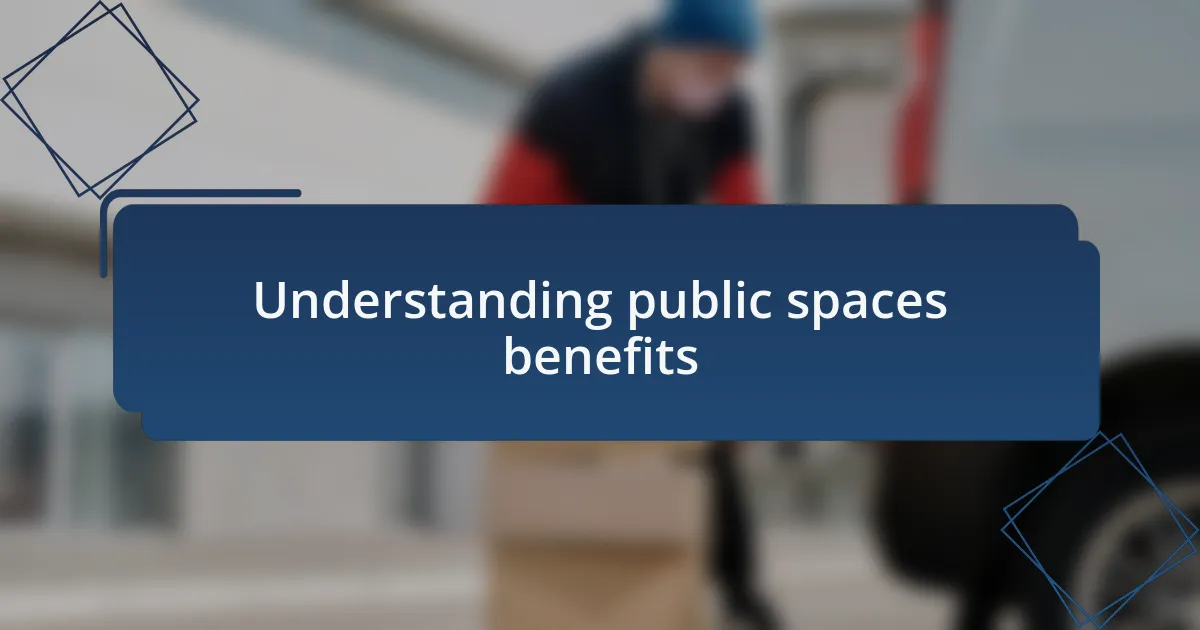
Understanding public spaces benefits
Public spaces serve as vital community hubs where people can connect, relax, and engage with their surroundings. I remember a sunny afternoon spent in a local park, watching children play and families picnicking. That experience reminded me how these spaces foster social interactions, making them essential for building a sense of belonging among residents.
Moreover, accessible public spaces promote inclusivity, particularly for individuals with mobility challenges. Think about how a well-designed pathway can create opportunities for everyone to enjoy outdoor activities. I often reflect on the joy it brings me to see friends with different abilities enjoying the same space, which reinforces the notion that everyone deserves equal access to community resources.
In addition, public spaces can positively impact mental health. When I step outside into an open area filled with greenery, I feel an immediate lift in my mood. Have you ever noticed how a change of scenery can refresh your mind? These spaces offer a necessary escape from the everyday hustle, reminding us that tranquility and nature can play a crucial role in our overall well-being.
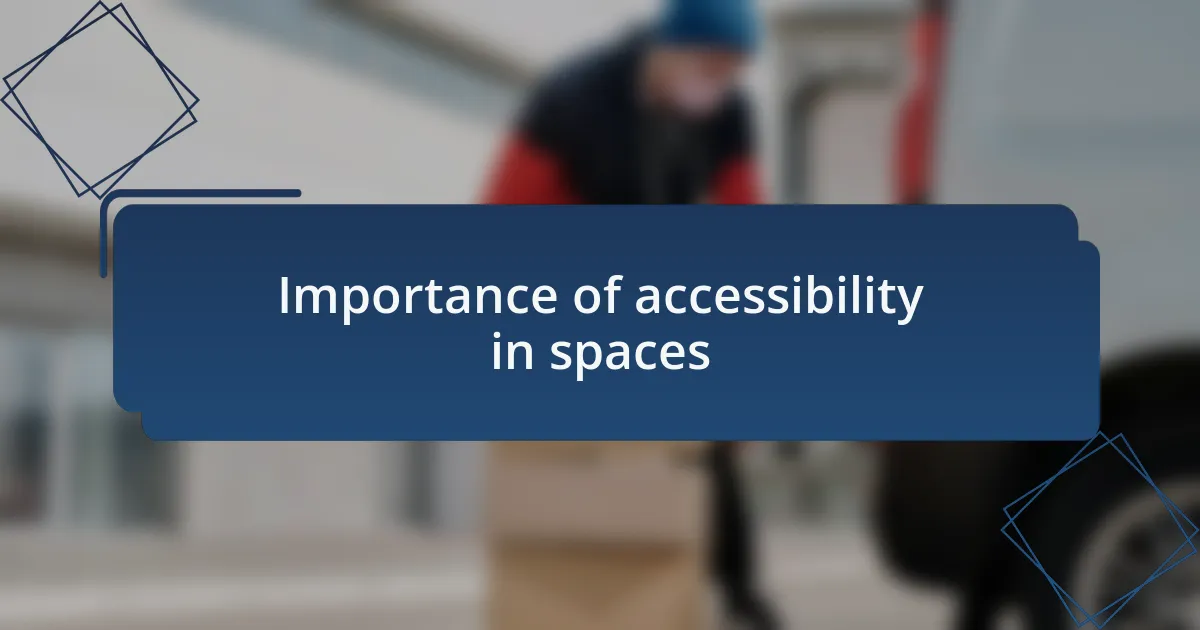
Importance of accessibility in spaces
Accessibility in public spaces is not just a matter of convenience; it profoundly affects the quality of life for individuals with disabilities. I once visited a museum designed with ramps and wide doorways, which allowed my friend in a wheelchair to navigate easily. Seeing their face light up as they explored the exhibits reinforced how important it is for every space to be welcoming, reminding me that our environments should empower rather than limit.
Consider the impact of accessible design on families as well. I vividly recall a community fair where the layout easily accommodated strollers and wheelchairs alike. This simple thoughtfulness allowed families to fully participate without stress or barriers. It struck me then how crucial it is to create environments where everyone can engage without fear of exclusion.
Accessibility is also a catalyst for community engagement. I often enjoy participating in events held in accessible parks, where people from all walks of life come together. Have you noticed how these gatherings seem to flourish when everyone can freely move and interact? When spaces are designed with accessibility in mind, they transform into vibrant centers of social interaction, enriching our collective experience.
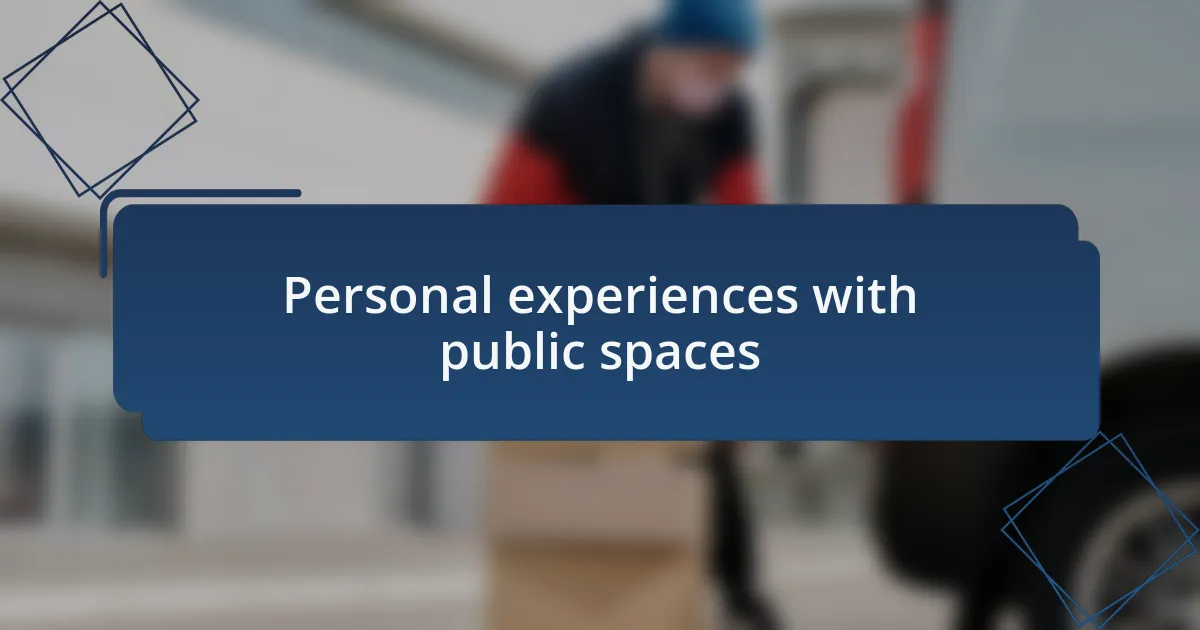
Personal experiences with public spaces
There was a time when I went to a local park with friends, and I felt a deep sense of relief in observing the smooth pathways. I remember pushing my own limits as I navigated the terrain, but I couldn’t shake off the feeling that others without mobility aids might struggle. It made me think: how many people miss out on the beauty of nature simply because a space isn’t designed with them in mind?
At a local café, I’ve experienced the joy of finding a table that gave ample room for my friends in wheelchairs to join our conversations comfortably. Their laughter filled the air as we shared stories, but it was the visible ease in their demeanor that truly touched me. That moment reinforced my belief that public spaces should not just be functional; they should foster connection and camaraderie.
One summer, I attended an outdoor concert where the organizers had made special accommodations. I witnessed individuals with various disabilities enjoying the event, and it brought me so much joy to see a diverse crowd reveling in music together. It struck me how these inclusive public spaces can uplift spirits and create beautiful memories. Isn’t it incredible how just a little thoughtfulness can transform an ordinary event into something extraordinary for everyone involved?
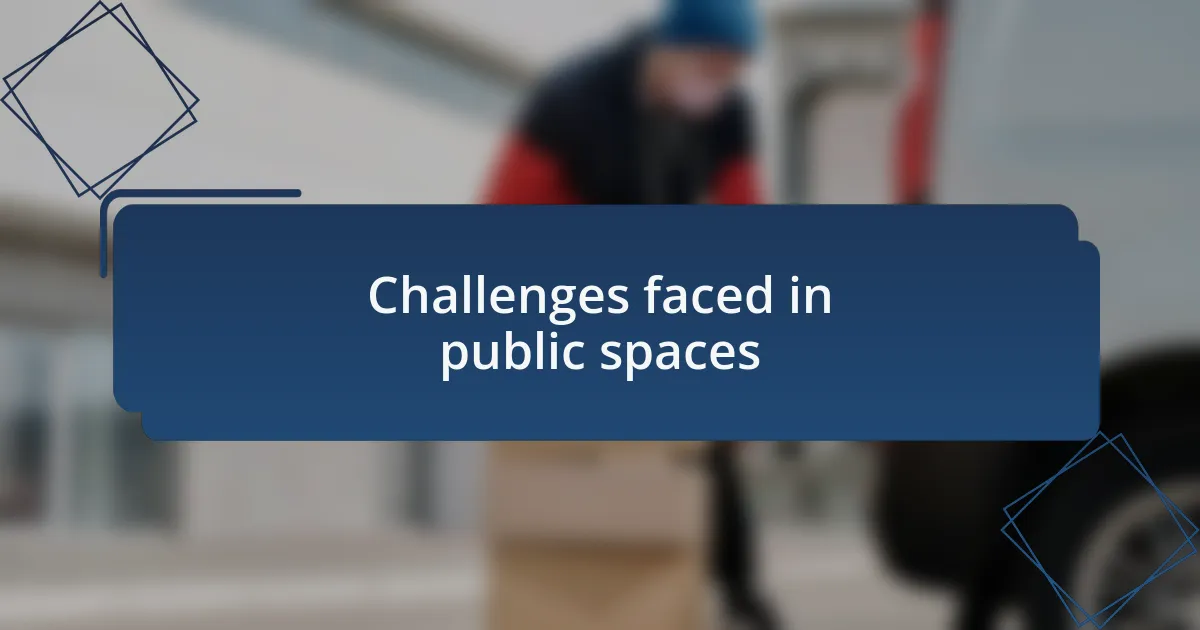
Challenges faced in public spaces
Navigating public spaces can often feel like an obstacle course rather than an enjoyable experience. I remember visiting a bustling mall where the accessible entrance was tucked away in a corner, far from the main entry point. It made me wonder, why is it that some spaces prioritize aesthetics over accessibility? This experience left me feeling sidelined, highlighting just how critical it is for public areas to be thoughtfully designed.
I find it particularly frustrating that many parks and recreational areas lack adequate seating and shaded spots for those who may need to rest. Once, while exploring a popular outdoor festival, I noticed my friend struggling to find a comfortable place to sit after walking for a while. It made me realize that a simple bench can be a sanctuary for someone with limited stamina. Why should this basic accommodation be so hard to find in a space meant for enjoyment?
While attending a city event focused on inclusivity, I observed the glaring absence of sign language interpreters, which left many unable to fully engage. This experience drove home the point that accessibility goes beyond physical barriers. How can we claim to celebrate diversity when communication remains limited for those who need it most? I believe that true inclusivity should embrace all aspects of participation, ensuring every voice is heard and valued.
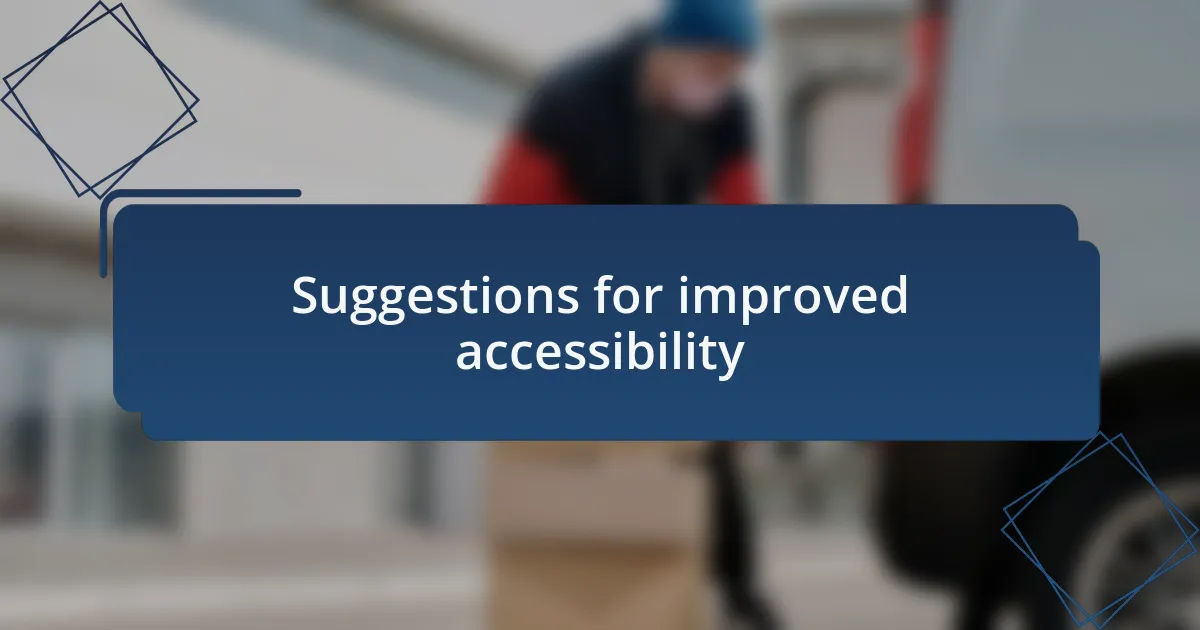
Suggestions for improved accessibility
When I think about improving accessibility in public spaces, one simple suggestion stands out: clear and consistent signage. I recall attending a community event where the layout was confusing, and many attendees, including myself, wandered aimlessly trying to locate essential facilities. It’s crucial to provide clear indications of accessible routes and amenities to enhance everyone’s experience. Why should navigating these areas feel like deciphering a complex puzzle?
Another vital aspect is the need for flexible seating arrangements. A few months back, I visited a city park with my family, and while enjoying the atmosphere, I noticed how difficult it was to find adjustable seating for individuals who require more support. Ideally, parks should offer a variety of seating options, accommodating various needs. Have we not all felt the relief of finding the right seat to rest our bodies and mind?
Moreover, incorporating sensory-friendly features can significantly enhance inclusivity. I remember attending a local festival that boasted vibrant decorations and loud music, which created a lively atmosphere but was overwhelming for some visitors. Providing quieter zones or sensory-friendly hours could ensure that everyone can enjoy public spaces without feeling overstimulated. Isn’t it time we cater to diverse sensory needs, allowing all individuals to partake comfortably?
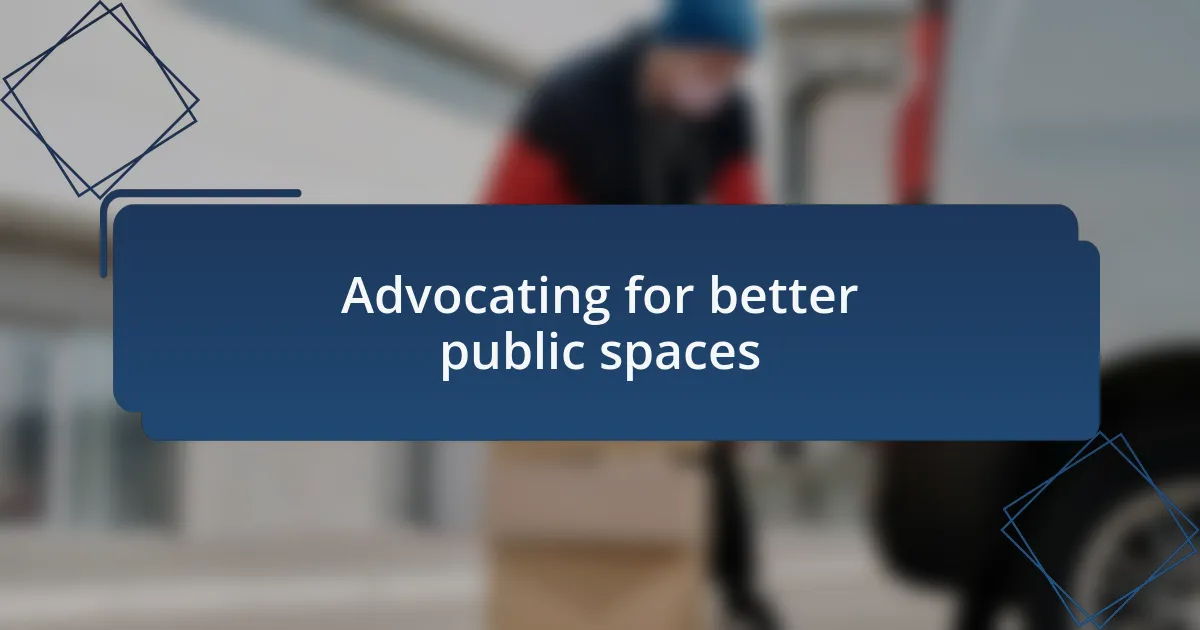
Advocating for better public spaces
The need for better public spaces goes beyond simple accessibility; it’s about creating welcoming environments for everyone. I once visited a community center that offered accessible facilities, yet the overall vibe felt uninviting. Imagine if we could transform these spaces into warm, friendly hubs where people with varying abilities feel encouraged to gather and connect. How can we foster a sense of belonging for all individuals?
Social interaction is vital for a thriving community, and inclusive public spaces play a key role in facilitating that. I recall sitting in a plaza where diverse groups congregated, sharing laughter and stories. However, it struck me that without proper accommodations, such as step-free paths or ramps, many individuals missed out on this enriching experience. Why should anyone feel excluded from community life just because the design doesn’t cater to their needs?
Additionally, engaging the public in design discussions can lead to spaces that truly reflect community values. The other day, I joined a town hall meeting where residents voiced their ideas for park enhancements. Hearing diverse perspectives sparked inspiration in me, highlighting how collaborative efforts make a difference. Shouldn’t we prioritize conversations that empower everyone to contribute to the spaces they inhabit?